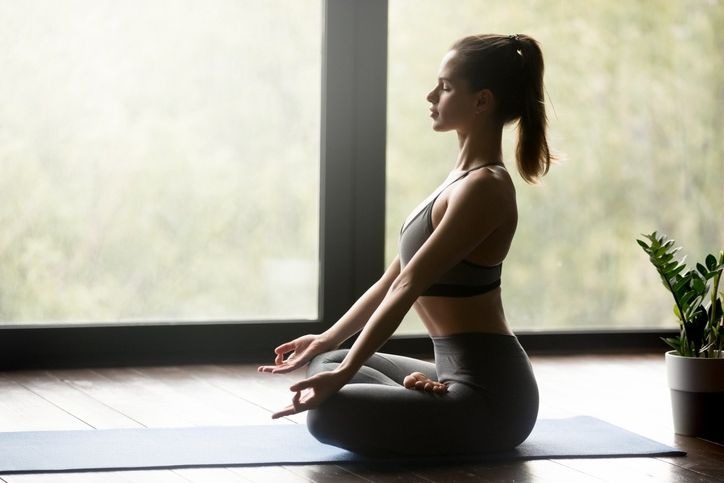How to practice breath-based meditation (the most powerful method)?
Caution : You must consult your doctor for your health. This page presents only a personal and alternative point of view which should not be considered as an attempt to prescribe medicine.
Meditation is a very ancient practice originating in India that has existed for thousands of years.
If many people are doing it today, it is because of the many benefits it provides.
Indeed, meditation allows you to free your mind and to feel better in your body.

This is what enables you to achieve a state of absolute well-being.
There are different meditation techniques including one based on breathing.
We explain how it works.
Find the place to meditate
This is the first thing to do when you want to practice breath-based meditation.
Find a very quiet place.
As this breathing technique is based on a (subtle) movement caused by your breath, it can very quickly be disturbed by noises.
It is therefore recommended to choose places isolated from noise.
It is also possible to do it at the foot of a tree in a forest, like the Buddha.
If you do not have access to this kind of location, simply opt for a very quiet room.
Note that once the location has been chosen, it is best that you use it the following times to meditate.
Indeed, by meditating, you will modify the energetic structure of the place, in other words, you will charge it with good energies.
Adopt a good posture
Do you want to get the benefits of breathing meditation?
So you can't just adopt any posture.
Indeed, to practice this kind of meditation, you must sit with your back straight.
You can sit on a chair or on a yoga mat in the lotus position.
For the lotus, place your left foot below your right thigh and the right foot below your left thigh.
If this position seems difficult to you, consider adopting another posture, but always making sure you have a straight back.
Get into an upright position with your head pushing up.
Then place the hands on the thighs while turning the palms of the hands towards the sky.
Learn to relax
Once you have adopted the correct posture, you must close your eyes.
Relax by releasing the tension as you breathe through your nose.
For a few moments, the tension disappears to lead you towards an awareness of the body.
This will make it easier for you to concentrate and focus when you observe your body.
Breathe well during meditation
To meditate, you need to work your breathing so that it becomes very still.
To do this, you need to adopt a fairly calm and slow breathing.
First take a deep, long breath to relax all the respiratory muscles.
Then exhale gently and long, letting go.
When you breathe out, you should feel each sensation in your throat, stomach or any other part of the body.
Choose one of the points where you feel your breath.
It can be the lips, the lungs or the tip of the nose, or just under the nose as in vipassana meditation.
Concentrate exclusively on the chosen point and then start the meditation.
You will notice that your breathing will be more and more calm as your concentration sharpens.
Do not try to think about each of the characteristics of the breath (length, rhythm, pressure and depth).
Do not also try to determine if it is natural or forced breathing.
Just focus your attention on the chosen point while witnessing your breathing.
NOTE: understand the nuance between observing directly and being a passive witness, is that you are not looking directly, but indirectly.
Throughout meditation, reject all thoughts by returning your attention to your chosen point of focus.
It will cleanse your mind by getting rid of your daily worries as well as thoughts about the past as well as the future.
All that matters is the present moment.
Some tips for successful breath meditation
In order to master this practice, you need to train regularly.
Wherever you are, practice breathing while maintaining some passive attention on your breath.
Whenever you want to practice meditation, try to return to the same passive level of concentration.
The intensity of your concentration during the meditation sessions should not vary.
This intensity must be constant, hence the importance of being in good shape.
Finally, avoid meditating when your stomach is too full or too empty.
Indeed, you must have a certain energy to meditate well and stay focused.
Having an overly full stomach could distract you or make you sleepy, which is very common.
In this case, that is also a good thing, because instead of meditating, you fell into sleep which means your body needed it.
In summary, the important thing for good meditation is to find a good location, to adopt the best position and above all to breathe well, or rather to let your breathing take place on its own.
However, knowing the right techniques is not enough to breathe well.
It will also be essential that you release your diaphragm because this is the biggest mistake I see around me.
Many people block their breath and their diaphragm, which makes it difficult to breathe well, but especially what prevents any form of deep meditation.
❤ The ultimate guide to breathing
Intermittent Breathing : Discover the method to quickly relieve your anxiety and chronic fatigue (positive effects from the first use).Read also :
Previous article : How to breathe better with COPD?
Next article : How to breathe with the diaphragm (breathing muscle)?

